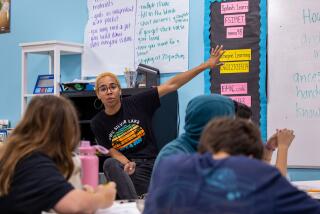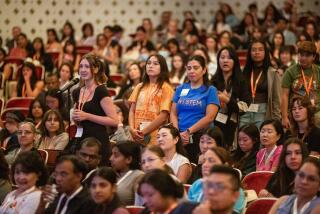Recipe for Science : Making sandwiches is just one way Laguna Beach youngsters learn in Jackie Howland’s lab. Support from a local foundation is a key ingredient to its success.
As the class begins, Jackie Howland passes out the bread, followed by peanut butter and jelly. But Howland isn’t serving lunch. She’s giving her third-graders a taste of science.
Today’s lesson is geology, and Howland’s pupils are constructing a sandwich representing the earth’s layers. When class is over, the children will get to eat their science projects, but until then the peanut butter and jelly sandwiches--with a sprinkling of raisins and cereal--are helping the pupils learn about the Earth’s core, mantle and crust.
“We’re not just building a sandwich,” Howland says. “We’re building a mountain. And through our sandwich, we can show how earthquakes happen.”
As a science teacher, Howland uses sandwiches, microscopes, anatomy models and even worms she digs up to teach important lessons to about 1,000 children in Laguna Beach’s two elementary schools.
Although she divides her time between El Morro and Top of the World elementary schools, she has fully stocked science labs at both locations. Throughout the school year, every class, including kindergarten, visits Howland’s labs for regularly scheduled lessons.
In addition to teaching science to children at both schools, Howland also works with other teachers in the district to help them keep up with the new science guidelines mandated by the state.
Technically, Howland is a full-time science teacher employed by the Laguna Beach Unified School District, but her entire salary and money to support the science program come from the Laguna Beach Education Foundation’s SchoolPower, an organization formed in 1981 to support the local schools.
“This is a real key position for us,” says Gwen Gross, principal at El Morro, where Howland teaches science every other week. “She works for the district, but the foundation gives the money with no strings attached.”
Since the foundation was established, it has contributed nearly $1.5 million to Laguna Beach schools. This year SchoolPower gave about $173,000 for programs ranging from music and art to staff development, according to Cathy Krinsky, a foundation spokesperson.
The elementary school science program has been in existence for eight years and costs about $54,000 a year.
“Science tends to be rather expensive,” Gross says, “but we feel strongly about math and science. And it was a big priority to have a lab here at school where kids could go and get instruction.”
Children meet in the science lab every other week for 45-minute lessons that supplement their day-to-day classroom studies. “This is all in addition to our standard curriculum,” Gross says.
“For children it is a neat alternative. They go into the lab, a new environment, and it’s a good positive experience, sort of a grown-up experience. One of the things that we have done is develop an inquisitive, investigative nature in our kids. They are bringing in samplings of rocks and things all the time. They have developed a real curiosity about their environment.”
The science program also teaches children to be inventive, Gross says. “We have an Invention Convention, and the kids come up with their own ideas. One boy last year used to chew on his shirt so he came up with an edible necktie so he wouldn’t chew on his shirt any more.”
Marian Vroman, a second-grade teacher at El Morro, says her pupils love going to the science lab. “And we all benefit because (Howland) supports what we are doing in the classroom. Last time they were learning about seeds. This time we’re talking about bats and hearing, so she’s doing something on sound.”
Howland covers everything from geology to chemistry, and her labs are well equipped with sophisticated items ranging from laser discs and microscopes to beakers and test tubes.
“In kindergarten, we begin with lessons on something about the five senses,” says Howland, a science specialist who competed with nearly 200 other applicants for her job. “We also do very simple experiments with plant life and how heat changes things. Then we go all the way up to chemistry in the fifth grade, converting starch into glucose, acid-based tests, force and motion.”
But the emphasis in every class is on what Howland calls “active learning.”
“This was an introductory lesson in geology today,” she says, referring to the sandwich building. “And now they can take this and move on. We can use the laser discs. We can talk about rocks. It is a step-by-step process. I believe in creating an environment for original thinking. I can start with a lesson, and they take it further. Hands-on is a wonderful way for kids to learn.”
Her ultimate goal, Howland says, is to turn her pupils into independent learners. “Because that’s how they are going to learn,” she says. “We can only present them with exciting opportunities.”
One exciting opportunity Howland recently offered her pupils is what she calls her worm experiment.
“I was trying to teach them that a scientist has to observe without prejudice,” she says. “That even though something appears to be something, we can’t assume. We have to test. So we observed worms. For example, do worms like light or dark?”
The experiment was a big hit with the kids, Howland says. Almost as big a hit as the class in which a group of fifth-graders dissected a cow’s heart.
Other favorite lessons include one on physical properties and liquid solutions. “I have the kids mix two powders with water and it turns a brilliant yellow. Then they add a liquid and a solid.”
Howland pauses and smiles. “It was vanilla pudding, and they got to eat it.”
The point is, Howland says, that science is all around us--in our kitchens, in our back yards, in our classrooms. “I want these kids to be able to say, ‘I love science.’ And I want them to go on in science because these are the kids that are going to change the face of the world.”
More to Read
Sign up for Essential California
The most important California stories and recommendations in your inbox every morning.
You may occasionally receive promotional content from the Los Angeles Times.










